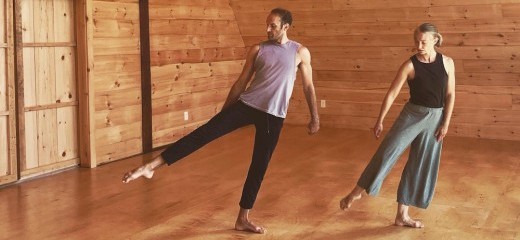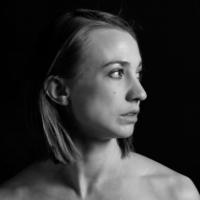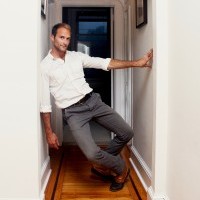
Dancing the Blue Road: Reflections on our Subcircle Farm Residency
By Ellie Goudie-Averill and Beau Hancock
“On the old highway maps of America, the main routes were red and the back roads blue. Now even the colors are changing. But in those brevities just before dawn and a little after dusk— times neither day nor night—the old roads return to the sky some of its color. Then, in truth, they carry a mysterious cast of blue, and it’s that time when the pull of the blue highway is strongest, when the open road is a beckoning, a strangeness, a place where a man can lose himself.” — William Least Heat-Moon, Blue Highways: A Journey into America.
We are on the screened porch of Subcircle’s dance residency space in Maine.* Beau, an artist-in-residence, invited Ellie to join him for this time of exploration, intensive making, and thinking about the process that we have already shared for about a year and a half. Throughout this time, we have worked both together and separately with a score that Beau built as a catalyst for uncharted movement-making and in response to William Least Heat-Moon’s bestseller, Blue Highways: A Journey into America (1982), in which he catalogued his adventures through the backroads of the United States. Similarly, we created a score of 45 body landmarks that asks us to reevaluate the physical pathways we travel as dancers. We play the score much like a Bach prelude is performed by a pianist, with interpretive potential and qualitative nuance as we move through the interior landscape of the body.
We have also been writing logs of our experience in the studio and we continue to include writing in our process during the residency. Today is Sunday and, comfortably seated in rocking chairs, we’re working on turning the writing into thick description, as Heat-Moon does in his text—anthropological musings on our own experiences. Our bodies are tired from days of intensive dancing from 10 a.m. to 5 p.m. each day, including warm-up, rehearsals, and quick swims in the cold ocean. The wind brushes the large oak in the front yard, cars speed past along Guinea Road. The porch is our favorite spot in the house, furnished with a blue rug, white rocking chairs, and wicker furniture that scream “Maine vacation home from the 1970s.” We love to watch the rippling leaves of the birch trees directly across from the house. Always shimmering. The old farmhouse has many beautiful oddities: small shelves and built-ins all over and, our favorite detail, a board between the kitchen and the dining room with a pleasing slope. It has been worn down from years of feet crossing that threshold, and yet it is still shiny and smooth. The rush of cars continues every few minutes, a counterpoint to the rustle of leaves and birdsong from nearby woods.
Subcircle calls this residency The Farm, an apt name for this former plant nursery rimmed with Maine forest. One of our hosts and the co-founder of Subcircle, Jorge Cousineau, let us know that the raspberries are in, random patches of bright red berries dotting the overgrown field left fallow a few years ago. Jorge and his collaborators Niki Cousineau and Scott McPheeters have been renovating not only the barn but also the adjacent farmhouse and grounds. Today they were planting flowers along a new deck next to the barn. They’re also cleaning out the old from the previous owner, what they fondly refer to as “Jackie’s junk.” Jackie owned what was then called Shamrock Farm; there remains a wooden shamrock sign on the barn.
The second floor of the classic red barn has been transformed into a dance studio, with golden wood walls and soft floor—a pleasant place to spend the day. The high-ceilinged studio has a particular warmth, not just because of the honey-colored wood, but from the love that clearly went into its design. It’s light-filled with a large rolling door and a freshly sanded smell. We open the four windows to let in the fresh, crisp air; we turn on the overhead fans to full blast when the sweat starts to pool. There are two chairs, one with chipping paint that ends up on our sweaty foreheads, in our hair, and on our feet. We love to look out at the field of high grass and wildflowers, untouched by development.
Outside on the landing, the old barn remains—darker, aged wood and a makeshift ladder to the first floor with its weathered wooden chairs, work tables, and two drawings from Laura Peterson, the first artist in residence, who left the day we arrived. Laura was tracking light in the studio with angle drawings, a sundial of sorts noting the changing shadows. According to Niki, Laura was working on repatterning her habits as a dancer and dance-maker during her residency, which sounds familiar to the Blue Highways score we have been working with in our making.
That’s what the Blue Highway score is meant to do: throw the dancer into the unknown, the unexpected, to routes in the body that haven’t been traveled. When we improvise to the score, we often get lost in the landmarks, uncertain of what came before and searching for what will come after. As we move into more set choreography, we struggle to keep the movement pregnant with that quality of searching.
Throughout his journey, Least Heat-Moon becomes more comfortable with encountering, conversing with, and relating to the folks he meets. The route that he chooses skirts the perimeter of our country, always traveling along the coasts and edges. Even in these far-flung places, he doesn't shy away from being himself—a midwestern man on a journey with no set destination. He tasks himself with being alone, with listening to whomever he meets, and with considering his choices. His writing is his catalyst for self-exploration, for charting his responses to the new places and faces he comes across. Similarly, we have tried to not shy away from ourselves, from our own choices, even as we challenge ourselves to improvise into new territory and learn set movement material that carries the same nuance and detail as the specific regions that Heat-Moon encounters and writes about along his route.
Similarly, what we would like to do in this dance is find new movement. One could argue that many choreographers have said that about their dance-making, and we are not even sure it’s truly possible. While we all have variations, our fundamental moving parts remain, their potential relatively fixed. But, optimists at heart, our desire to transcend these limits keeps us delighting in what dancing might offer to us and to our communities. What we’d like this dance to do is bring the viewer the particular pleasure that traveling the U.S. gave Heat-Moon through charting the less convenient path, the effort making the sweetness of discovery all the more special. We’d like this dance to end in a place we would not expect, to take a shape we haven’t thought of yet, and maybe shift the viewer’s understanding of how to value movement. Maybe it can shift our perspectives on what we value in movement.
*The Farm is Subcircle’s new dance-focused residency site in Biddeford, Maine. Stone Depot’s Beau Hancock, along with Laura Peterson, was in the first invited cohort for a fully-funded residency. Hancock is a former member of thINKingDANCE.
Subcircle Farm Residency, July 10-20
By Eleanor Goudie-Averill and Beau Hancock
By Eleanor Goudie-Averill
July 25, 2019















